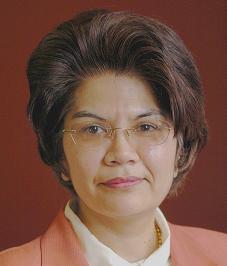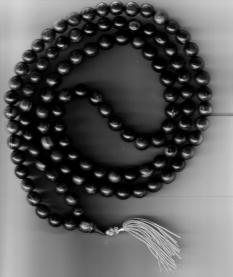Guest Editor: Vivian-Lee Nyitray, University of California, Riverside
Editor: Tazim R. Kassam, Syracuse University
 Tazim R. Kassam, Spotlight on Teaching Editor Tazim R. Kassam, Spotlight on Teaching Editor
Typically, Muslims have a tasbih at hand to remember God. Tasbih means to exalt, praise and glorify God; and the prayer beads used to aid this glorification are also called tasbih, subha or misbaha. Like Hindu and Buddhist malas and Catholic rosaries, their essential function is to concentrate the mind to count devotions, prayers, and divine attributes. Each religious tradition has its own local lore about the beads, their craftsmanship, and their talismanic powers. Tasbihs are made of ninety-nine beads that signify the asma al-husna, the ninety-nine most beautiful names of God mentioned in the Qur’an.
The ubiquity of tasbihs in mosques, homes, and around the wrists of Muslim men and women illustrates the importance of dhikr or constant recollection of God in Islam. Always in search of pictures and videos to use in class, I found one of President Hamid Karzai in a meeting with Afghan leaders holding prayer beads in his hands and another of Muslim men sitting in an Egyptian café talking while they fingered and counted their beads. A website called “Islam for Children” lists prayer beads among various essential Islamic artifacts including the prayer rug, prayer compass to determine the direction of Mecca, prayer caps, and Qur’an stand.
So much for simple descriptions and catalogues of religious symbols in Islam. Things matter. At times, things matter more than the ideas from which they take shape. This hit home when I heard an elderly Muslim woman instruct her husband not to carry his tasbih on their flight from Toronto to New York a year after the tragic events of 9/11. This unexpected precaution poignantly problematized the tension and ambiguity of reckoning with religious symbols and artifacts in different contexts. In between the idea (as in thought and desire) of the tasbih (to glorify God) and its materiality (prayer beads) is a constructive and deconstructive space, which continues to require critical reflection.
 The focus of this issue of Spotlight on Teaching, guest edited by Vivian-Lee Nyitray, is material culture in religious studies. A longstanding debate in the field of religion has been the relationship between religious beliefs and practices or the classic philosophical problem of spirit and matter, essence and manifestation, noumenon and phenomenon. In pedagogical terms, the dilemma surfaces in terms of striking the right balance between teaching about a religious tradition’s ideas and principles versus teaching about its religious practices and artifacts. It is possible to do one to the exclusion of the other as well as to address both without theorizing the intimate yet ambivalent relationship between the two. For instance, until a few decades ago, occidentalist versions of Islam rooted exclusively in textual, normative sources managed to represent this cumulative historical tradition without any reference to how Muslims in different parts of the world actually expressed their faith in everyday life and practice. The pendulum now swings in the other direction as attention is drawn to the many discrete and varied cultural manifestations of Muslim life. This pedagogy is founded on the assumption that being Muslim, Hindu, Christian, and so on generates a particular type of material culture which embodies and replicates the teachings and requirements of a specific faith. It also emerges from the pressing need, voiced by our students, to understand other people’s religious symbols in a pluralist society. The focus of this issue of Spotlight on Teaching, guest edited by Vivian-Lee Nyitray, is material culture in religious studies. A longstanding debate in the field of religion has been the relationship between religious beliefs and practices or the classic philosophical problem of spirit and matter, essence and manifestation, noumenon and phenomenon. In pedagogical terms, the dilemma surfaces in terms of striking the right balance between teaching about a religious tradition’s ideas and principles versus teaching about its religious practices and artifacts. It is possible to do one to the exclusion of the other as well as to address both without theorizing the intimate yet ambivalent relationship between the two. For instance, until a few decades ago, occidentalist versions of Islam rooted exclusively in textual, normative sources managed to represent this cumulative historical tradition without any reference to how Muslims in different parts of the world actually expressed their faith in everyday life and practice. The pendulum now swings in the other direction as attention is drawn to the many discrete and varied cultural manifestations of Muslim life. This pedagogy is founded on the assumption that being Muslim, Hindu, Christian, and so on generates a particular type of material culture which embodies and replicates the teachings and requirements of a specific faith. It also emerges from the pressing need, voiced by our students, to understand other people’s religious symbols in a pluralist society.
 Yet, how to tackle both descriptively and theoretically the visible aspects of religion remains. The edifice of disciplinary-specific language used to construct diverse explanations of religious objects itself requires constant re-examination. Terms used in the classroom to “handle” religious objects including manifestation, sacred, hierophany, representation and so on are themselves implicitly structured on a dualistic metaphysics of reality. Thus, within the context of coming to understand religious life through, not in spite of, material culture, there is both opportunity and necessity to draw attention to the limitations of epistemological notions constantly at work in the acts of explanation. Yet, how to tackle both descriptively and theoretically the visible aspects of religion remains. The edifice of disciplinary-specific language used to construct diverse explanations of religious objects itself requires constant re-examination. Terms used in the classroom to “handle” religious objects including manifestation, sacred, hierophany, representation and so on are themselves implicitly structured on a dualistic metaphysics of reality. Thus, within the context of coming to understand religious life through, not in spite of, material culture, there is both opportunity and necessity to draw attention to the limitations of epistemological notions constantly at work in the acts of explanation.
|
![PDF-NOTE: Internet Explorer Users, right click the PDF Icon and choose [save target as] if you are experiencing problems with clicking.](http://rsnonline.org/templates/rsntemplate-smallmasthead/images/pdf_button.png)

![PDF-NOTE: Internet Explorer Users, right click the PDF Icon and choose [save target as] if you are experiencing problems with clicking.](http://rsnonline.org/templates/rsntemplate-smallmasthead/images/pdf_button.png)
